Questions Answered by N. R. Woodward
Author of The Glass Insulator in America
Reprinted from "INSULATORS - Crown Jewels of the Wire", February 1979, page 12
Jack Goodew, Jr.,
Medford, N.Y. writes:
I would like to know if you have any information on the
type of insulator shown here. The front is embossed BROOKFIELD PAT.OCT.8-1907
There is no other embossing. Collectors and linemen that are familiar with this
type say it's scarce, but they're only local friends. I would like to know what
you think. I once had ten of these things and traded them away for carnival,
purple, amber and blue types. I think it was a good trade.
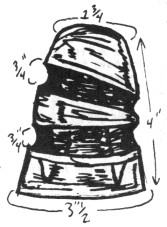
In reply to Jack
Goodew, Jr.:
Your Brookfield CD 150 insulator is quite a desirable item. It
shows up in their 1912 catalog as their Number 42, Deep Groove, Double
Petticoat, External Thread Insulator. Although not extremely old, it evidently
never became a standard item with any major user; and they are scarce today!
Unless the colors you traded for are very special in some way other than the
color, I'm afraid the other fella got the best end of the deal.
- - - - - - - - -
From Greg &
Margaret Robertson:
Recently at a garage sale we purchased two CD 233's (F-Pyrex
Reg.U.S.Pat. Off. B- 661/Corning Made in U.S.A.) Someone had painted them a
transparent red. We bought them knowing they were painted. We used lacquer thinner to take the red paint off. Underneath it was clear. Milholland's book
doesn't have them listed in clear, just carnival and yellow. Could the yellow
have come off with the red paint, or were they made in clear also? If so, how
much would it be worth? Before we cleaned one you could scratch it and see
yellow underneath. We have one still painted red.
- - - - - - - - -
In reply to Greg &
Margaret Robertson:
Most of the Corning insulators were made of glass that is
essentially clear, but has a varying degree of yellow tint. The thickness of the
glass and the particular light source when viewing make them look more or less
yellow. I would think that your specimens are probably the usual ones which are
in fact nearly clear. The color of the glass could not be changed by the
cleaning process you describe. When you first scraped the red paint, your
impression of yellow color came from refracted light from the paint job, which
would make a true evaluation of the glass color impossible.
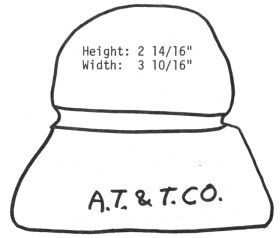
Mark Zamboni, Pittsburgh, Pa., writes:
A few months ago I went to a local show and picked up
a CD 193 A. T. & T. CO., light aqua, NM-. So far I have not been able to
find a price for this, and I can't find it in Milholland's book. I was hoping
you could help me with this insulator, finding a price and telling me whether it
is common or not. P.S. I bought it for a quarter. Thanks for your time.
- - - - - - - - -
In reply
to Mark Zamboni:
Your A. T. & T. Co. transposition top is a CD 191, rather
than 193. It shows up in Line 2582, Milholland-Keating price list. A real buy
for $.25 though
From Rick Herrera, Fort Worth, Tex.:
Recently at a flea market I
got an aqua Brookfield CD 121, S.D.P., with Brookfield on the front and this on
the back and wondered if anyone could tell me why this marking on the back.

Could it cover another embossing? These are raised above the glass.
Secondly, I
have a CD 152 , It. blue, with no embossing except NO 48. On the top is this
marking.

I wonder if you could tell me what this means. I have others that have
numbers on their tops.
- - - - - - - - - -
In reply to Rick Herrera:
The engraving in your CD 121
molds was originally A.T.& T.Co. These molds were used first to make the
last of the insulators marked especially for American Telephone & Telegraph
Co.; then the same molds were used to make the much more numerous BROOKFIELD CD
121. The odd marks on the "back" of your insulator are where the
original engraving was covered.
The no-name No. 48 sometimes has a "1"
on the crown; and I suspect that the odd pattern on yours is where the hot glass
squirmed around the bottom of the mold as it fell in and tried to pick up the
"1" several times. This happened quite often with older insulators and
resulted in double or "shadow" markings of various configurations.
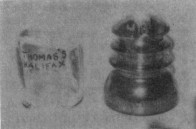
Craig Bruegger, Colona, Ill., writes:
I have two insulators that I hope
you can help me with.
The first is a Whitall Tatum No 10. It is a very light
silvery carnival glass. I wrote to Don Wentzel who was involved with a Whitall
Tatum. He thinks it might have been an experimental attempt at carnival.
The
other is a glass dome with an indentation on the front. The name on the front
is: THOMAS'S HALIFAX. On the back in small print is: made in england. I have no
idea what it might be or what its use is. The insulator is lighter in color than
the picture shows.
I would be grateful for any information you can give me.
- - - - - - - - - -
In
reply to Craig Bruegger:
Although Whitall Tatum (and Armstrong) were making
insulators at the time Owens-Illinois and Corning were into the iridizing thing,
insofar as I know, we have no definite knowledge that any iridized insulators
were ever made at Millville. This does not prove that they weren't, though.
During the period to which your insulator seems to belong, some Whitall Tatum
glass was quite yellow. When this yellow glass gets buried for a time in
alkaline soil, the resultant etching on the yellow glass makes a surface very
similar in appearance to iridizing. Could this be what you have?
Mike Doyle,
Annandale, Va., states:
I would like to know what years Brookfield put style
numbers on their insulators, such as NO 9, NO 36 and NO 20.
- - - - - - - - - -
In reply to Mike
Doyle:
While we have no definite information and probably never will, all
evidence indicates that the style numbers were added to Brookfield insulators
during the last few years of their manufacture. Some, such as No. 3 TRANS. were
probably made earlier; but the No. 9, 36, 38 and 48, for example, tie in with
the last efforts of the company, during and immediately following World War I.
Also the mold numbers (appearing on the skirts and not to be confused with
earlier shop numbers on the crowns) belong to the same period.
From David Turner, Virginia Beach, Va.:
I am writing about a CD 733 insulator that I have
had for some time. It is embossed W. BROOKFIELD, 4 55 FULTON ST N.Y. On the back
it says: CAUVETS PAT JULY 25 1865. Directly above the patent date are some very
small numbers: 5, 1865. It appears that the whole insulator was embossed in this
way and was re-stamped. I was wondering if this is unusual and also why I cannot
find #4 in any books? I can find only #1 and #5. Any information you can give me
as to value, age will help.
- - - - - - - - -
In reply to David Turner:
The CD 733 with
shop number 4 would probably best fit the 1868-1870 period. On insulators that
old, we have mostly logical deductions to rely on, since there are no written
records that would answer minor detail questions.
The shop numbers had no
significance after the insulator was packed for shipment, and one could only
guess that not so many were made using the number 4. In my personal records I
don't show a 4 in a comparable insulator made with threads, either.
Insofar as
the small figures are concerned, there were some molds during that period that
were engraved with very small characters. One could only guess that the mold was
re-engraved with larger characters, and the small ones were not entirely covered.
The insulator itself would not have been "re-stamped", as there would
be no way to do that. In cases where there is "shadow" embossing, it
is the same type as the main embossing, so the above explanation would be about
the only one for your most interesting specimen.
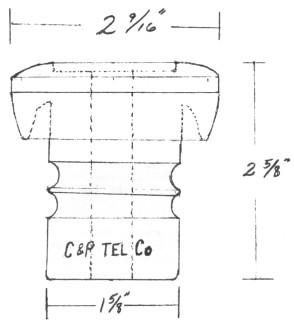
Kenneth M. House, Casselberry,
Fla., writes:
While a friend and I were digging for bottles and insulators in
Maryland, we found a dead end insulator embossed: C & P TEL Co. I have
enclosed a description, and would like to know if any collectors might have
it in mint for trade or sale. This insulator is medium aqua glass. Would you
know of any information on it?
P.S. Would there be a CD number assigned to
this insulator?
- - - - - - - - - -
In reply to Kenneth M. House:
Your Chesapeake & Potomac
Telephone Co. dead end insulator is quite unique! I've not seen this, nor any
other insulator of a similar style made or embossed specifically for telephone
work. If other Crown Jewels readers have, let us know about it!
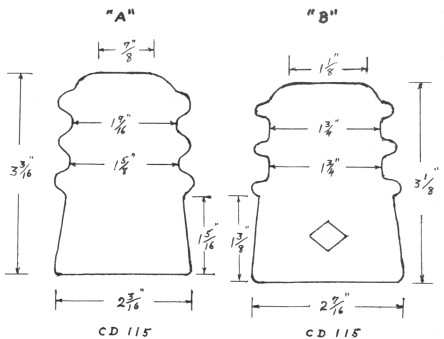
From Doug Henderson:
Above are two profile drawings of two CD 115 insulators. One, exhibit
"B", is the ordinary CD 115, and the profile is that of a
"Diamond" insulator. The other, exhibit "A", is the profile
of a "No Name".
The late Mr. Milholland showed this insulator to Mr.
Woodward, and when it was returned to me both gentlemen were of the opinion that
it was a CD 115, and Mr. Milholland had made a notation that it was a dandy. It
is a medium dark aqua with many bubbles. As can be seen by the illustration, it
is of a general CD 115 design; but the wire grooves and ridges are very
different.
I would like to know if there are many insulators similar to this
one. Perhaps some of the Crown Jewels readers may have this insulator and would
comment on its scarcity or commonness.
Also, I have four Brookfield two piece
transpositions, CD 191, 190, which came off a local telephone line a number of
years ago, and which are different in their marking from the regular two piece
transpositions. The bottoms, or CD 190, have a 6 rather than a B.

These sixes
are perfect, and not like the imperfect B's which are deformed because of
imperfections in the engraving for the letters in the mold. (See tracings
above.)
Can you comment on this type of CD 190, or perhaps some fellow collector
has one or has seen this variety?
Any information on the above two insulators
would be appreciated.
- - - - - - - - - -
In reply to Doug Henderson:
Your CD 190 with only a
6 is a stranger to me. But there is a rather typical A.T.& T. Co. CD 190
made by Brookfield that has just such a 6 as you describe to the left of the
A.T.& T.Co. embossing. Check your CD 190 for possible covered engraving in
the mold a little way to the right of the 6. I'm surmising that these may be the
same molds with the A.T.& T.Co. removed, but the shop number left, and no
other embossing substituted.
As to the CD 115 with no embossing and rounded wire
grooves: I have no idea of its origin. I've seen no others. Perhaps other
readers can comment?
Dennis E. Crossland writes:
I need help in finding out the
CD number of an insulator I have found! Please help! Skirt (F) W. BROOKFIELD,
(B) NEW YORK, crown (top) I -SB- Petticoat- heavy thick glass, in order of CD
134, but wider and heavier, 4" H, 3-1/2" Base, light aqua color. Can
you help me?
- - - - - - - - - -
In reply to Dennis E. Crossland:
It looks as if you have a CD 162.
If it doesn't fit there, we would need a more accurate description, or to see
the insulator, in order to place it properly.
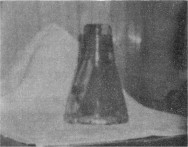
Kenneth La Frenier writes from
Phillipston, Mass.:
I am sending you a picture of an insulator that I picked
up at a flea market. Could you give me any information on what type it is? It
measures six inches across the base, nine inches in height. It has six wire
grooves on the outside. Its weight is four pounds. The color is aqua. It is
crude looking and appears old to me. I would really appreciate any information
you could give me. Thank you.
- - - - - - - - - -
Your insulator is in reality half an insulator! It
is the center of a Locke high tension line insulator from the very early 1900's.
The enclosed copy of a page from the 1904 Locke catalog shows their No. 25,
which is made using the center piece that you have. Also, around 1900 and
possibly for some time thereafter, a porcelain top was used with this same glass
center. Either way, it is Locke glass made by Brookfield. The same style as
Locke No. 25 shows in the 1912 Brookfield catalog, but probably most of these
were used 1900-1910.
As you can see, the six "wire grooves" are not
that at all, but are ridges to anchor the center securely when it is cemented
into the top.
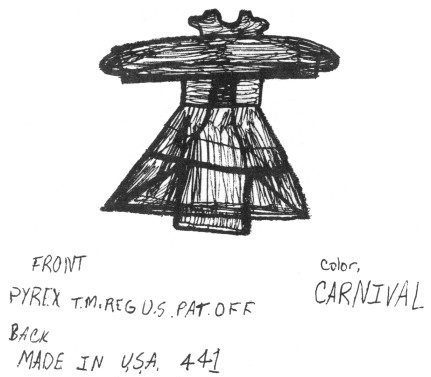
From
Jack Goodew, Jr., Medford, N.Y.:
This is another specimen that I have, but no
information on it. These are considered scarce around here. These were also made
in clear by Corning Pyrex, but they're not worth as much.
- - - - - - - - -
In reply to Jack
Goodew, Jr.:
The Pyrex No. 441 was one of the more common of their line. We have
no production or sales records on those or any of the Corning insulators; but
many hundreds of them were in service in Southern California and in the
Northwest, as well as in the East. All of those that I saw on the West Coast
were clear, though. The enclosed page from a Corning catalog, not dated, but
about 1935, shows the specifications for the 441.
| 